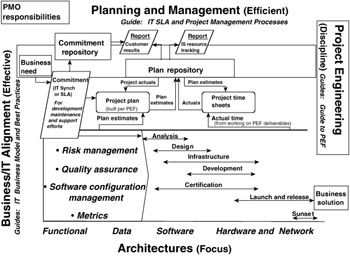The Role of the Project Management Office in Project Management Services
|
| < Day Day Up > |
|
Although all of the processes described in this chapter have some merit and may even work for your own organization, there is no simple way to implement such a vast array of practices. Admittedly, the methods outlined here carry with them a certain level of administrative overhead. On the other hand, the cost of developing and maintaining these processes will prove insignificant when balanced against the payback — high-quality customer relationships and repeatable success in IT project delivery. But the question remains: "How does an IT organization achieve the level of self-management prescribed in this chapter?" Here is my answer: "Establish a project management office to ensure the synchronization of service level and project delivery."
Because many of the tasks cited in this chapter must be accomplished in the course of project delivery anyway, it is more efficient to establish a center of excellence in these skills that in turn ensures broad-based IT compliance with best practices. Furthermore, nothing about the processes described herein is static. As IT and its customers learn from the use of these processes, they will fine tune and adapt them based on practical experience. PMO personnel will become the keepers and the chroniclers of this institutional learning and its knowledge management by-products. Because they operate independently of any particular IT service delivery or project team, PMO staff are in a position to advocate for and monitor the success of commitment management and service/project delivery processes.
In closing, Exhibit 11 offers one last image for framing the role of the PMO in the context of overall IT project delivery. Although this illustration is rather busy, it is also accurate in its conveyance of the various dimensions of the PMO's contribution to the health of the project management process. [15]
Exhibit 11: A Project Delivery Framework for the PMO

Along the left axis are references to business and IT alignment. As you may recall, Chapter 3 identifies a number of supporting roles for the PMO in the fashioning of the IT organization's annual plan. These activities provide PMO personnel with a comprehensive and timely understanding of IT team goals, objectives, and priorities for the coming year. In short, the process gives them insight into the right things to do. Proceeding to the top axis and IT's planning and management processes, PMO personnel assist in the crafting of SLAs and commitment documents that in turn define what, how, and by whom services and projects will be delivered to IT's customers. Here, the PMO serves as the keeper of past IT team experience, the promoter of best industry practices, and as the scribe and coordinator of IT delivery and customer relationship management processes.
Along the bottom axis is the project delivery life cycle, when PMO project managers and business analysts participate directly in delivery. Here, they are not only members of the support team but also directly creating customer value through their efforts. Furthermore, the PMO will continue to monitor overall life-cycle management and recommend process improvements as these emerge from the project delivery teams. Lastly, the bottom axis suggests how the PMO — as the promoter of standard practices; of the reuse of information, tools, templates, and technical components; and of adherence to IT's technical architecture — helps to keep the rest of the IT organization focused on the right things and to avoid reinventing the wheel with each new assignment. All in all, Exhibit 11 nicely summarizes what the PMO can and should do for the IT organization it serves.
All in all, the frameworks and tools outlined in this chapter should prove useful in controlling initial project scope and preventing project scope "creep." Furthermore, my communication and reporting approaches will ensure that all project stakeholders keep abreast of development and have opportunities to contribute to project discussions.
[15]For an electronic version of the framework, see The Hands-On Project Office, http://www.crcpress.com/e_products/downloads/download.asp?cat_no=AU1991, chpt5~21~project engineering framework~model.
|
| < Day Day Up > |
|
EAN: 2147483647
Pages: 132
- Challenging the Unpredictable: Changeable Order Management Systems
- Distributed Data Warehouse for Geo-spatial Services
- A Hybrid Clustering Technique to Improve Patient Data Quality
- Relevance and Micro-Relevance for the Professional as Determinants of IT-Diffusion and IT-Use in Healthcare
- Development of Interactive Web Sites to Enhance Police/Community Relations